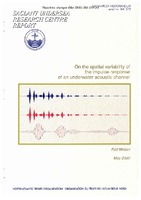| dc.contributor.author | Weber, Rolf | |
| dc.date.accessioned | 2018-10-11T14:09:03Z | |
| dc.date.available | 2018-10-11T14:09:03Z | |
| dc.date.issued | 2000/05 | |
| dc.identifier | 12464 | |
| dc.identifier.govdoc | SM-373 | |
| dc.identifier.uri | http://hdl.handle.net/20.500.12489/558 | |
| dc.description.abstract | In many applications like adaptive equalization, beam-forming, matched field processing or focalization the performance is limited due to changes in the impulse response caused by variations in source-receiver range or in bathymetry. As one wishes to quantify the degree of degradation and possibly compensate them it is important to understand the effects of parameter variations on the impulse response. This report focuses on examining the similarities of simulated impulse responses belonging to scenarios in which environmental parameters are changed one at a time. As a measure | |
| dc.description.abstract | of similarity the classical correlation coefficient and the maximum magnitude of the cross correlation function between the complex equivalent lowpass representation of the signals are introduced and their properties are discussed. The results of the correlation analysis demonstrate the properties of the two correlators and show the limits of their applicability. Furthermore, they give evidence that some parameter perturbations are more critical for impulse response variations than others. | |
| dc.format | vi, 28 p. : ill. ; 10 fig. | |
| dc.language | English | |
| dc.publisher | NATO. SACLANTCEN | |
| dc.subject | Acoustic propagation | |
| dc.subject | Correlation techniques | |
| dc.title | On the spatial variability of the impulse response of an underwater acoustic channel | |
| dc.type | Scientific Memorandum (SM) | |
